Ford Fusion Hybrid 2010 User Manual
|
Table of Contents |
|
|
Introduction |
4 |
|
|
|
|
Instrument Cluster |
16 |
|
|
Warning lights and chimes |
16 |
Gauges |
23 |
Message center |
32 |
|
|
Entertainment Systems |
48 |
|
|
AM/FM stereo with CD/MP3 |
48 |
Auxiliary input jack (Line in) |
56 |
USB port |
58 |
Satellite radio information |
61 |
Navigation system |
64 |
SYNC |
64 |
|
|
Climate Controls |
65 |
|
|
Dual automatic temperature control |
65 |
Navigation system based climate control |
67 |
Rear window defroster |
71 |
|
|
Lights |
72 |
|
|
Headlamps |
72 |
Turn signal control |
76 |
Bulb replacement |
77 |
|
|
Driver Controls |
82 |
|
|
Windshield wiper/washer control |
82 |
Steering wheel adjustment |
83 |
Power windows |
89 |
Mirrors |
91 |
Speed control |
93 |
Moon roof |
97 |
1
2010 Fusion Hybrid (hfv)
Owners Guide, 1st Printing USA (fus)

Table of Contents
Locks and Security |
100 |
|
|
Keys |
100 |
Locks |
102 |
Anti-theft system |
114 |
|
|
Seating and Safety Restraints |
120 |
|
|
Seating |
120 |
Safety restraints |
131 |
Airbags |
145 |
Child restraints |
161 |
|
|
Tires, Wheels and Loading |
180 |
|
|
Tire information |
180 |
Tire inflation |
182 |
Tire Pressure Monitoring System (TPMS) |
195 |
Vehicle loading |
199 |
Trailer towing |
205 |
Recreational towing |
205 |
|
|
Driving |
206 |
|
|
Starting |
206 |
Brakes |
210 |
AdvanceTrac |
213 |
Transmission operation |
220 |
Reverse sensing system |
222 |
Rear-view camera system |
224 |
|
|
Roadside Emergencies |
233 |
|
|
Getting roadside assistance |
233 |
Hazard flasher control |
234 |
Fuses and relays |
235 |
Changing tires |
243 |
Wheel lug nut torque |
249 |
Jump starting |
250 |
Wrecker towing |
255 |
2
2010 Fusion Hybrid (hfv)
Owners Guide, 1st Printing USA (fus)
Table of Contents |
|
|
|
Customer Assistance |
257 |
|
|
Reporting safety defects (U.S. only) |
263 |
Reporting safety defects (Canada only) |
263 |
|
|
Cleaning |
264 |
|
|
|
|
Maintenance and Specifications |
271 |
|
|
Engine compartment |
273 |
Engine oil |
275 |
Battery |
277 |
Engine Coolant and Motor/Electronics Coolant |
280 |
Fuel information |
285 |
Air filter(s) |
297 |
Part numbers |
297 |
Maintenance product specifications and capacities |
298 |
Engine data |
300 |
|
|
Accessories |
303 |
|
|
|
|
Scheduled Maintenance Guide |
305 |
|
|
Normal scheduled maintenance and log |
309 |
Special operating conditions and log |
315 |
|
|
Ford Extended Service Plan |
318 |
|
|
|
|
Index |
321 |
|
|
All rights reserved. Reproduction by any means, electronic or mechanical including photocopying, recording or by any information storage and retrieval system or translation in whole or part is not permitted without written authorization from Ford Motor Company. Ford may change the contents without notice and without incurring obligation.
Copyright © 2008 Ford Motor Company
3
2010 Fusion Hybrid (hfv)
Owners Guide, 1st Printing USA (fus)

Introduction
CONGRATULATIONS
Congratulations on acquiring your new Ford. Please take the time to get well acquainted with your vehicle by reading this handbook. The more you know and understand about your vehicle, the greater the safety and pleasure you will derive from driving it.
For more information on Ford Motor Company and its products visit the following website:
•In the United States: www.ford.com
•In Canada: www.ford.ca
•In Australia: www.ford.com.au
•In Mexico: www.ford.com.mx
Additional owner information is given in separate publications.
This Owner’s Guide describes every option and model variant available and therefore some of the items covered may not apply to your particular vehicle. Furthermore, due to printing cycles it may describe options before they are generally available.
Remember to pass on this Owner’s Guide when reselling the vehicle. It is an integral part of the vehicle.
WARNING: Fuel pump shut-off switch: In the event of an accident the safety switch will automatically cut off the fuel
supply to the engine. The switch can also be activated through sudden vibration (e.g. collision when parking). To reset the switch, refer to the
Fuel pump shut-off switch in the Roadside Emergencies chapter.
SAFETY AND ENVIRONMENT PROTECTION
 Warning symbols in this guide
Warning symbols in this guide
How can you reduce the risk of personal injury to yourself or others? In this guide, answers to such questions are contained in comments highlighted by the warning triangle symbol. These comments should be read and observed.
4
2010 Fusion Hybrid (hfv)
Owners Guide, 1st Printing USA (fus)
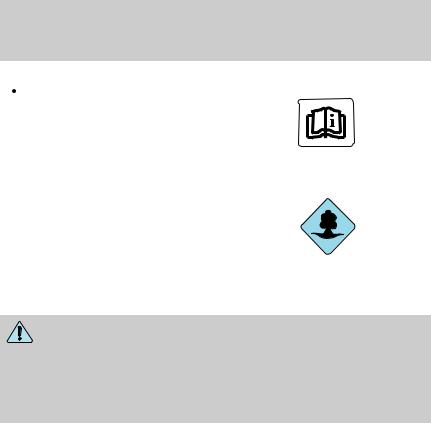
Introduction
 Warning symbols on your vehicle
Warning symbols on your vehicle
When you see this symbol, it is imperative that you consult the relevant section of this guide before touching or attempting adjustment of any kind.
Protecting the environment
We must all play our part in protecting the environment. Correct
vehicle usage and the authorized disposal of waste, cleaning and
lubrication materials are significant
steps towards this aim. Information in this respect is highlighted in this guide with the tree symbol.
CALIFORNIA Proposition 65 Warning
WARNING: Engine exhaust, some of its constituents, and certain vehicle components contain or emit chemicals known to
the State of California to cause cancer and birth defects or other reproductive harm. In addition, certain fluids contained in vehicles and certain products of component wear contain or emit chemicals known to the State of California to cause cancer and birth defects or other reproductive harm.
PERCHLORATE MATERIAL
Certain components of this vehicle such as airbag modules, seat belt pretensioners, and button cell batteries may contain Perchlorate Material
– Special handling may apply for service or vehicle end of life disposal. See www.dtsc.ca.gov/hazardouswaste/perchlorate.
BREAKING-IN YOUR VEHICLE
Your vehicle does not need an extensive break-in. Try not to drive continuously at the same speed for the first 1,000 miles (1,600 km) of new vehicle operation. Vary your speed frequently in order to give the moving parts a chance to break in.
Do not add friction modifier compounds or special break-in oils since these additives may prevent piston ring seating. See Engine oil in the Maintenance and Specifications chapter for more information on oil usage.
5
2010 Fusion Hybrid (hfv)
Owners Guide, 1st Printing USA (fus)

Introduction
HYBRID OPERATION
This hybrid vehicle combines electric and gasoline propulsion without compromise, to provide breakthrough performance and efficiency. It requires no special fuels and never has to be plugged in. Familiarizing yourself with these unique characteristics will help ensure optimal performance from your new vehicle.
Normal vehicle operation
Starting: Turn the ignition key to the start position while your vehicle is in P (Park). A green vehicle symbol (called the Ready Indicator Light) will appear in the instrument cluster to indicate the vehicle is on. This indicator will remain on while the vehicle is on, whether the engine is running or not to indicate the vehicle is capable of movement (using its electric motor, engine, or both). The vehicle’s computer will determine if an engine start is required. Typically, the engine will not start unless the vehicle is cold, a climate control change is requested, or the accelerator is depressed.
Note: You may notice higher engine speeds upon start-up. This temporary condition is normal and necessary to heat up the cabin and minimize emissions.
Driving: The gas engine automatically starts and stops to provide power when it’s needed and to save fuel when it’s not. While coasting at low speeds, coming to a stop, or standing, the gas engine normally shuts down and the vehicle operates in electric-only mode. Conditions that may cause the engine to start up or remain running include:
•Considerable vehicle acceleration
•Vehicle speed above 45 mph (73 kmh)
•Ascending a hill
•Charge level of high voltage battery is low
•Very high or low outside temperature (to provide system cooling/heating)
•Engine not warm enough to provide passenger requested cabin temperature
Stopping: The gas engine may shut off to conserve fuel as you come to a stop. Restarting the vehicle is not required. Simply step on the accelerator when you are ready to drive.
Transmission Operation: Due to the technologically advanced, electronically controlled Continuously Variable Transaxle (eCVT) you will
6
2010 Fusion Hybrid (hfv)
Owners Guide, 1st Printing USA (fus)

Introduction
not feel shift changes like those of a non-hybrid vehicle. Your hybrid’s transmission is designed to do its work seamlessly.
Since engine speed is controlled by the transmission, it may seem elevated at times. This is normal hybrid operation and helps deliver fuel efficiency and performance.
Neutral: It is not recommended to idle the vehicle in N (Neutral) for extended periods of time because this will discharge your high voltage battery and decrease fuel economy. Because of the unique nature of the hybrid vehicle, the engine will not start in the N (Neutral) position. Also, the engine cannot provide power to the hybrid system in N (Neutral).
Low Gear: L (Low gear) is designed to mimic the enhanced engine braking available in non-hybrid vehicles. L (Low gear) will produce high engine speeds to provide necessary engine braking. This is normal and will not damage your vehicle.
Reverse: (R) Reverse Gear vehicle speed is limited to 22 mph (35 km/h).
Unique Hybrid operating characteristics
Your Hybrid, with its new technology, behaves differently compared to a non-hybrid. Here is a description of the major differences:
Battery: Your Hybrid is equipped with a high voltage battery. A cool battery ensures battery life and provides the best possible performance. Your hybrid high voltage battery may periodically re-condition itself to ensure maximum efficiency. You may notice slight changes in drivability during this process, but it’s an important part of your hybrid’s high voltage battery optimization features.
The high voltage battery is cooled by cabin air drawn from vent holes in the front of the rear seat cushions. Avoid placing objects at the vent holes which block air flow to the high voltage battery.
The high voltage battery is located between the rear passenger seat and the trunk. Due to this location, the rear seat for the hybrid vehicle does not have the ability to be lowered to allow pass-through between the trunk and the rear of the passenger compartment. Do not attempt to lower the rear seat.
If the vehicle is left inoperative for over 31 days, it may be necessary to jumpstart the vehicle. For more information, refer to Jump starting (Low voltage [underhood] battery only) in the Roadside Emergencies chapter and also refer to Low and high voltage battery — storage in the Maintenance and Specifications chapter.
7
2010 Fusion Hybrid (hfv)
Owners Guide, 1st Printing USA (fus)

Introduction
Engine: The engine speed in your hybrid is not directly tied to your vehicle speed. Your vehicle’s engine and transmission are designed to deliver the power you need at the most efficient engine speed. During heavy accelerations, your hybrid may reach high engine speeds (up to 6000 RPM). This is characteristic of the Atkinson cycle engine technology helping to maximize your hybrid’s fuel economy.
In prolonged mountainous driving, you may see the engine tachometer changing without your input. This is intentional and maintains the battery charge level. You may also notice during extended downhill driving that your engine continues to run instead of shutting off.
During this “engine braking”, the engine stays on, but it’s not using any fuel. You may also hear a slight whine or whistle when operating your vehicle. This is the normal operation of the electric generator in the hybrid system.
During certain events (such as vehicle servicing) your low voltage (underhood) battery may become disconnected or disabled. When this occurs, and after reconnecting the low voltage (underhood) battery and driving the vehicle, the engine may continue to operate for 3-5 seconds after the key is turned to the off position. This is a normal condition, as the vehicle’s computers are relearning the operating characteristics of your particular engine in order to operate it at maximum efficiency.
Braking: Your hybrid is equipped with standard hydraulic braking and regenerative braking. Regenerative braking is performed by your transmission and it captures brake energy and stores it in your high voltage battery.
Driving to optimize fuel economy
Your fuel economy should improve throughout your hybrid’s break-in period. As with any vehicle, fuel economy can be significantly impacted by your driving habits and accessory usage. For best results, keep in mind these tips:
Tire Inflation: Keep tires properly inflated and only use recommended size.
Drive Habits: Aggressive driving increases the amount of energy required to move your vehicle. In general, better fuel economy is achieved with mild to moderate acceleration and deceleration. Moderate braking is particularly important since it allows you to maximize the energy captured by the regenerative braking system.
NOTE: Having your engine running is not always an indication of inefficiency – in some cases it is actually more efficient than driving in electric mode.
8
2010 Fusion Hybrid (hfv)
Owners Guide, 1st Printing USA (fus)

Introduction
Additional Tips:
•Do not carry extra loads
•Be mindful of adding external accessories that may increase aerodynamic drag
•Observe posted speed limits
•Perform all scheduled maintenance
•There is no need to wait for your engine to “warm up”. The vehicle is ready to drive immediately after starting
Refer to Essentials of Good Fuel Economy in Maintenance and Specifications chapter for more fuel saving tips.
Frequently asked questions
Question |
Answer |
What are the series |
The high voltage battery is electrically isolated |
of clicks from the |
from the rest of the vehicle when the key is OFF. |
cargo area when I |
When the key is turned ON, high voltage |
first turn the key in |
contactors inside the battery are closed to make |
the ignition? |
the electricity available to the motor/generator |
|
and enable the vehicle to drive. The clicks are the |
|
sound of these contactors as they close and open |
|
during start up and shut down. |
Why does the |
The vehicle’s computer will determine if an |
engine sometimes |
engine start is required at key-on. The engine will |
start at key-on? |
start if it is necessary for cabin heating or |
|
windshield defrost. The engine will also be started |
|
when ambient temperatures are low. |
Why does it take a |
There are several reasons the engine stays on for |
long time before |
an extended amount of time when it is first |
the engine shuts |
started. One common reason is to ensure that the |
down? |
emissions components are warm enough to |
|
minimize tailpipe emissions. As the climate gets |
|
cooler, this “engine-ON” time is extended. |
9
2010 Fusion Hybrid (hfv)
Owners Guide, 1st Printing USA (fus)

Introduction
Question |
Answer |
Why does my |
The engine is required to turn on above this |
engine never shut |
speed to protect the transmission hardware. |
down above 45 mph |
|
(73 km/h)? |
|
Why does my |
In order to ensure that the climate control system |
engine stay ON |
can begin heating the cabin and/or defrosting the |
when it’s extremely |
windshield as soon as a driver requests it, the |
cold outside? |
engine coolant temperature has to be kept |
|
sufficiently hot. Keeping the engine on is required |
|
to maintain the correct minimum temperature. |
Why does my |
Your vehicle’s engine and transmission are |
engine rev up so |
designed to deliver the power you need at the |
high sometimes |
most efficient engine speed. This may be higher |
when I accelerate? |
than expected during heavy accelerations, and |
|
may fluctuate during steady state driving. These |
|
are characteristics of the Atkinson engine cycle |
|
and the eCVT transmission technology that help |
|
maximize your hybrid’s fuel economy. |
What is the fan |
The fan noise comes from a fan located inside the |
noise I hear from |
high voltage battery. This fan turns on when the |
the rear of my |
battery requires cooling air. The fan speed, and |
hybrid? |
associated noise level, will change according to |
|
the amount of cooling required to maintain good |
|
performance. Maintaining the battery temperature |
|
at optimal conditions also prolongs the useful life |
|
of the battery and helps to achieve better fuel |
|
economy. |
How far can I go in |
Running out of gas is not recommended. |
Electric Drive if I |
However, you may be able to go about one mile, |
run out of gas? |
driving at 30 mph (48 km/h), if the battery has a |
|
normal state of charge. |
10
2010 Fusion Hybrid (hfv)
Owners Guide, 1st Printing USA (fus)

|
Introduction |
|
|
Question |
Answer |
What is the engine |
The engine oil should be changed every |
oil change service |
10,000 miles (16,000 km) under normal operating |
interval? |
conditions. See the Scheduled Maintenance |
|
Guide chapter. |
Can I put E10 or |
Your hybrid vehicle can use E10 (10% ethanol, |
E85 in my vehicle, |
90% gasoline) fuel, but you may notice slightly |
and how will it |
reduced fuel economy because ethanol contains |
affect my fuel |
less energy per gallon than gasoline. Your hybrid |
economy? |
vehicle is not designed to use E85 (85% ethanol). |
How long will my |
The high voltage battery system is designed to |
high voltage battery |
last the life of the vehicle and requires no |
last? Does it need |
maintenance. |
maintenance? |
|
Can you charge the |
There are no provisions for charging the high |
battery with a plug |
voltage battery from a power supply external to |
into an A/C outlet? |
the vehicle. |
Can I tow the hybrid |
Yes. Your hybrid vehicle can be “flat-towed” |
behind my motor |
without modification. See the Recreational |
home with all four |
Towing section in the Tires, Wheels and |
wheels down? |
Loading chapter for more information. |
SPECIAL NOTICES
New Vehicle Limited Warranty
For a detailed description of what is covered and what is not covered by your vehicle’s New Vehicle Limited Warranty, refer to the Warranty Guide/Customer Information Guide that is provided to you along with your Owner’s Guide.
Special instructions
For your added safety, your vehicle is fitted with sophisticated electronic controls.
WARNING: Please read the section Airbag Supplemental Restraint System (SRS) in the Seating and Safety Restraints
chapter. Failure to follow the specific warnings and instructions could result in personal injury.
11
2010 Fusion Hybrid (hfv)
Owners Guide, 1st Printing USA (fus)

Introduction
WARNING: Front seat mounted rear-facing child or infant seats should NEVER be placed in front of an active passenger airbag.
Service Data Recording
Service data recorders in your vehicle are capable of collecting and storing diagnostic information about your vehicle. This potentially includes information about the performance or status of various systems and modules in the vehicle, such as engine, throttle, steering or brake systems. In order to properly diagnose and service your vehicle, Ford Motor Company, Ford of Canada, and service and repair facilities may access vehicle diagnostic information through a direct connection to your vehicle when diagnosing or servicing your vehicle. For U.S. only (if equipped), if you choose to use the SYNC Vehicle Health Report, you consent that certain diagnostic information may also be accessed electronically by Ford Motor Company and Ford authorized service facilities, and that the diagnostic information may be used for any purpose. See your SYNC supplement for more information.
Event Data Recording
Other modules in your vehicle — event data recorders — are capable of collecting and storing data during a crash or near crash event. The recorded information may assist in the investigation of such an event. The modules may record information about both the vehicle and the occupants, potentially including information such as:
•how various systems in your vehicle were operating;
•whether or not the driver and passenger seatbelts were buckled;
•how far (if at all) the driver was depressing the accelerator and/or the brake pedal;
•how fast the vehicle was traveling; and
•where the driver was positioning the steering wheel.
To access this information, special equipment must be directly connected to the recording modules. Ford Motor Company and Ford of Canada do not access event data recorder information without obtaining consent, unless pursuant to court order or where required by law enforcement, other government authorities or other third parties acting with lawful authority. Other parties may seek to access the information independently of Ford Motor Company and Ford of Canada. Please note that once 911 Assist (if equipped) is enabled (set ON), 911 Assist may, through any paired and connected cell phone, disclose to emergency
12
2010 Fusion Hybrid (hfv)
Owners Guide, 1st Printing USA (fus)

Introduction
services that the vehicle has been in a crash involving the deployment of an airbag or, in certain vehicles, the activation of the fuel pump shut-off. Certain versions or updates to 911 Assist may also be capable of electronically or verbally disclosing to 911 operators the vehicle location, and/or other details about the vehicle or crash to assist 911 operators to provide the most appropriate emergency services. If you do not want to disclose this information, do not activate the feature. See your SYNC supplement for more information.
Cell phone use
The use of Mobile Communications Equipment has become increasingly important in the conduct of business and personal affairs. However, drivers must not compromise their own or others’ safety when using such equipment. Mobile Communications can enhance personal safety and security when appropriately used, particularly in emergency situations. Safety must be paramount when using mobile communications equipment to avoid negating these benefits.
Mobile Communication Equipment includes, but is not limited to cellular phones, pagers, portable email devices, in-vehicle communications systems, telematics devices and portable two-way radios.
WARNING: Driving while distracted can result in loss of vehicle control, accident and injury. Ford strongly recommends that
drivers use extreme caution when using any device that may take their focus off the road. The driver’s primary responsibility is the safe operation of their vehicle. Only use cell phones and other devices not essential to the driving task when it is safe to do so.
Export unique (Non–United States/Canada) vehicle specific information
For your particular global region, your vehicle may be equipped with features and options that are different from the features and options that are described in this Owner’s Guide. A market unique supplement may be supplied that complements this book. By referring to the market unique supplement, if provided, you can properly identify those features, recommendations and specifications that are unique to your vehicle. This Owner’s Guide is written primarily for the U.S. and Canadian Markets. Features or equipment listed as standard may be different on units built for Export. Refer to this Owner’s Guide for all other required information and warnings.
13
2010 Fusion Hybrid (hfv)
Owners Guide, 1st Printing USA (fus)
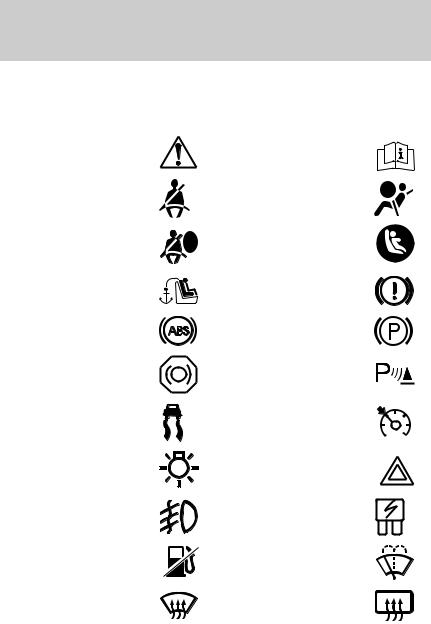
Introduction
These are some of the symbols you may see on your vehicle.
Vehicle Symbol Glossary |
||
Safety Alert |
See Owner’s Guide |
|
Fasten Safety Belt |
Airbag - Front |
|
Airbag - Side |
Child Seat Lower |
|
Anchor |
||
|
||
Child Seat Tether |
Brake System |
|
Anchor |
||
|
||
Anti-Lock Brake System |
Parking Brake System |
|
Brake Fluid - |
Parking Aid System |
|
Non-Petroleum Based |
||
|
||
Stability Control System |
Speed Control |
|
Master Lighting Switch |
Hazard Warning Flasher |
|
Fog Lamps-Front |
Fuse Compartment |
|
Fuel Pump Reset |
Windshield Wash/Wipe |
|
Windshield |
Rear Window |
|
Defrost/Demist |
Defrost/Demist |
|
14
2010 Fusion Hybrid (hfv)
Owners Guide, 1st Printing USA (fus)
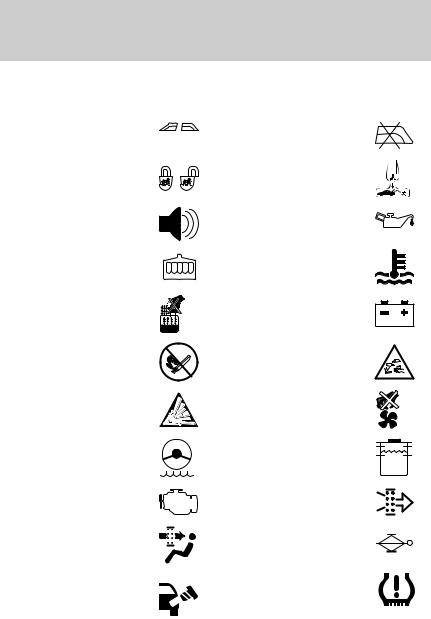
Introduction
Vehicle Symbol Glossary
Power Windows |
Power Window Lockout |
|
Front/Rear |
||
|
||
Child Safety Door |
Interior Luggage |
|
Lock/Unlock |
Compartment Release |
|
Panic Alarm |
Engine Oil |
|
Engine Coolant |
Engine Coolant |
|
Temperature |
||
|
||
Do Not Open When Hot |
Battery |
|
Avoid Smoking, Flames, |
Battery Acid |
|
or Sparks |
||
|
||
Explosive Gas |
Fan Warning |
|
Power Steering Fluid |
Maintain Correct Fluid |
|
Level |
||
|
||
Service Engine Soon |
Engine Air Filter |
|
Passenger Compartment |
Jack |
|
Air Filter |
||
|
||
Check Fuel Cap |
Low Tire Pressure |
|
Warning |
||
|
MAX
MIN
15
2010 Fusion Hybrid (hfv)
Owners Guide, 1st Printing USA (fus)
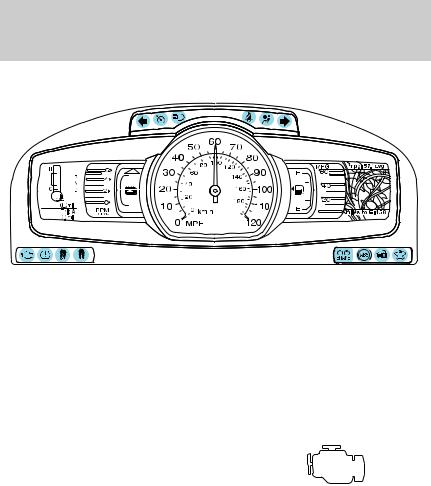
Instrument Cluster
WARNING LIGHTS AND CHIMES
Warning lights and gauges can alert you to a vehicle condition that may become serious enough to cause extensive repairs. A warning light may illuminate when a problem exists with one of your vehicle’s functions.
Many lights will illuminate when you start your vehicle to make sure the bulbs work. If any light remains on after starting the vehicle (such as the light), refer to the respective system light explanation later in this section for additional information.
Note: Some warning lights are reconfigurable telltale (RTT) indicators; they will display in the message center and function the same as the warning light, but they will not display on startup as regular warning lights do.
Service engine soon: The service engine soon light illuminates when the ignition is turned to the on position to check the bulb.
•Illuminates with key on, vehicle off: If the light illuminates, the service engine soon light is working properly.
•Illuminates with key on, vehicle off, then starts to blink: The light illuminates when the ignition is turned to the on position to check the bulb and to indicate whether the vehicle is ready for Inspection/Maintenance (I/M) testing. If after 15 seconds the Service engine soon light blinks eight times, it means that the vehicle is not ready for Inspection/Maintenance (I/M) testing. This can occur if the vehicle’s engine or transmission has just been serviced, or the battery has recently run down or been disconnected. If the vehicle does not need I/M testing, do nothing. The vehicle is designed to check the
16
2010 Fusion Hybrid (hfv)
Owners Guide, 1st Printing USA (fus)

Instrument Cluster
emission control system during normal driving. If the vehicle needs I/M testing, refer to the Readiness for Inspection/Maintenance (I/M) testing section in the Maintenance and Specifications.
•Illuminates with engine running: The light stays on after the engine is started. It indicates that the On Board Diagnostics System has detected a problem with the engine, transmission or an emission-related component or system. Contact your authorized dealer as soon as possible. The vehicle will usually be drivable and will not require towing. Refer to On Board Diagnostics (OBD-II) in the owner guide for information on temporary malfunctions that may not require vehicle service.
•Blinks with engine running: The light stays on after the engine is started and sometimes blinks. It indicates that the On Board Diagnostics System has detected an engine misfire problem with the engine. While the light is blinking, engine misfire is occurring which could damage your catalytic converter. Drive in a moderate fashion (avoid heavy acceleration and deceleration) and contact your authorized dealer as soon as possible.
WARNING: Under engine misfire conditions, excessive exhaust temperatures could damage the catalytic converter, the fuel
system, interior floor coverings or other vehicle components, possibly causing a fire.
Brake system warning: To confirm |
! |
P |
the brake system warning light is |
||
functional, it will momentarily |
BRAKE |
|
illuminate when the ignition is |
||
turned to the on position (when the
engine is not running), or in a position between on and start, or by applying the parking brake when the ignition is turned to the on position. If the brake system warning light does not illuminate at this time, contact your authorized dealer as soon as possible. Illumination after releasing the parking brake indicates low brake fluid level. Contact your authorized dealer as soon as possible.
17
2010 Fusion Hybrid (hfv)
Owners Guide, 1st Printing USA (fus)

Instrument Cluster
WARNING: Driving a vehicle with the brake system warning light on is dangerous. A significant decrease in braking
performance may occur. It will take you longer to stop the vehicle. Contact your authorized dealer as soon as possible. Driving extended distances with the parking brake engaged can cause brake failure and the risk of personal injury.
Anti-lock brake system: If the
ABS light stays illuminated or ABS continues to flash, a malfunction has
been detected. Contact your authorized dealer as soon as
possible. Normal braking is still functional unless the brake warning light also is illuminated.
Check brake system/Brake fluid |
! |
|
level low (RTT): Indicates the |
||
braking system is not operating |
BRAKE |
|
properly or that the brake fluid level |
||
|
||
is low. A message may also display |
|
in the message center. Contact your authorized dealer as soon as possible.
Parking brake engaged (RTT): |
P |
Displays when the parking brake is |
|
engaged. A message may also |
BRAKE |
display in the message center. |
Airbag readiness: The warning light illuminates momentarily when
the ignition is turned to the on position. The supplementary
restraint system includes the airbags and seat belt buckle pretensioners. If this light fails to illuminate when the ignition is turned on, continues to flash or remains on, contact your authorized dealer as soon as possible. A chime will sound if there is a malfunction in the indicator light.
Safety belt: The warning light illuminates momentarily when the ignition is turned to the on position. Illuminates to remind you to fasten your safety belt. A Belt-Minder
18
2010 Fusion Hybrid (hfv)
Owners Guide, 1st Printing USA (fus)
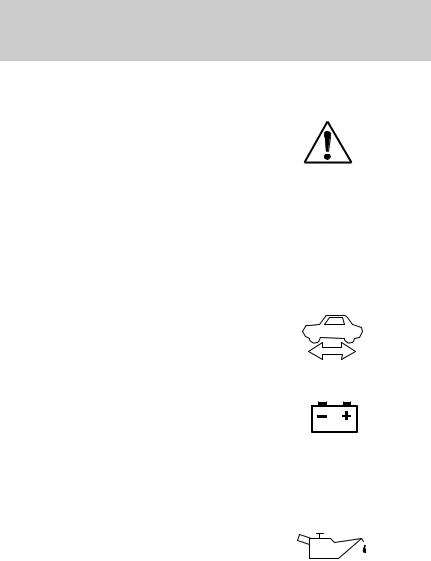
Instrument Cluster
chime will also sound to remind you to fasten your safety belt. Refer to the Seating and Safety Restraints chapter to activate/deactivate the Belt-Minder chime feature.
Stop safely hazard warning (RTT): Indicates Hybrid component fault/failure that will cause the vehicle to shutdown, fail to start or
enter into a limited operating mode. A message may also display in the message center.
Note: If the vehicle is still running, the vehicle may soon shutdown without further warning and should be stopped safely.
If this lamp is lit, stop the vehicle, shift to P (Park), turn the key to the off position, and attempt to restart the vehicle. If the fault remains, the vehicle may require refueling, jump starting or service. For information regarding the low-voltage (12–volt) battery only, please refer to the
Roadside Emergencies chapter.
Ready to drive: Illuminates once the vehicle has successfully started and will remain lit throughout the drive. Indicates the vehicle is ready to drive even when you don’t hear the gasoline engine running.
Charging system (RTT):
Illuminates when the low-voltage (12-volt) battery is not charging
properly. The message center
displays CHECK CHARGING SYSTEM. If it stays on while the vehicle is running (Ready to drive indicator is illuminated), there may be a malfunction with the charging system. Contact your authorized dealer as soon as possible. This indicates a problem with the electrical system or a related component.
Engine oil pressure (RTT):
Illuminates when the oil pressure falls below the normal range. The
message center displays LOW OIL
PRESSURE when the engine oil level is low. Check the oil level and add oil if needed. If the warning light or message stays on, even though the oil level is correct, do not start the engine and contact your authorized dealer as soon as possible. This indicates a problem with the engine or a related component. Refer to Engine oil in the Maintenance and Specifications chapter.
19
2010 Fusion Hybrid (hfv)
Owners Guide, 1st Printing USA (fus)
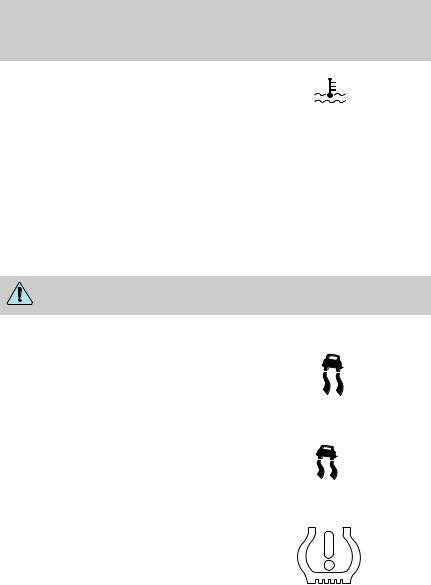
Instrument Cluster
High engine or high motor
electronic coolant temperature (RTT): Illuminates when the engine
coolant or motor electronics coolant temperature is high. The message center displays HIGH ENGINE TEMPERATURE / HIGH MOTOR TEMPERATURE when the engine coolant or motor electronics are overheating. Stop the vehicle as soon as safely possible, turn off the engine, and let it cool. Check the coolant and coolant level. If the light and message stays on or continues to turn on after the vehicle warms up, contact your authorized dealer as soon as possible. Continuing to drive with an overheated engine can cause serious engine damage. This indicates a problem with the engine or a related component. Refer to
Engine coolant and motor/electronics coolant in the Maintenance and Specifications chapter.
WARNING: Never remove the coolant reservoir cap while the engine is running or hot.
AdvanceTrac /Traction
Control™: Illuminates when the AdvanceTrac /Traction Control™ is
active. If the light remains on, contact your authorized dealer as
soon as possible. Refer to the Driving chapter for more information.
AdvanceTrac /Traction |
|
Control™ off: Illuminates when |
|
the AdvanceTrac /Traction |
|
Control™ has been disabled by the |
OFF |
driver. Refer to the Driving chapter |
|
for more information. |
|
Low tire pressure warning:
Illuminates to warn you when your tire pressure is low. If the telltale remains on solid at start up or while
driving, the tire pressure should be
checked. The message center will also display LOW TIRE PRESSURE when one or more tires on your vehicle have low tire pressure.
20
2010 Fusion Hybrid (hfv)
Owners Guide, 1st Printing USA (fus)
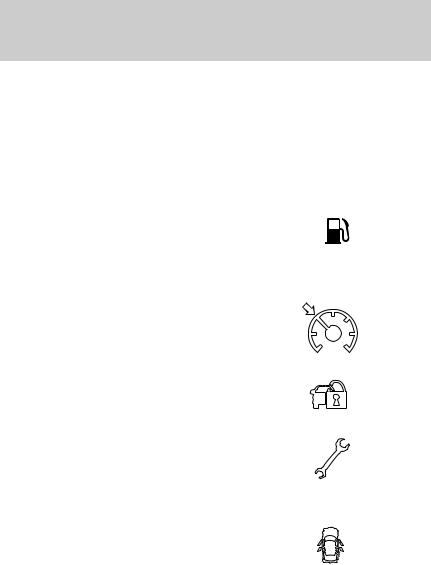
Instrument Cluster
The telltale can also warn you when the system is malfunctioning. If the telltale begins to flash, when the ignition is first turned on or while driving, contact your authorized dealer as soon as possible. The message center will also display TIRE PRESSURE SENSOR FAULT or TIRE PRESSURE MONITOR FAULT when the system is malfunctioning.
Please note that if your spare tire is in use, the damaged road tire must be re-installed on your vehicle to restore system functionality. For more information on this system, refer to Tire pressure monitoring system (TPMS) in the Tires, Wheels and Loading chapter.
Low fuel (RTT): Displays when the fuel level in the fuel tank is at or near empty. The fuel gage will turn yellow and then red depending
on fuel level. A message may also display in the message center. Refer to Fuel gauge in this chapter.
Speed control: Illuminates when the speed control is engaged. Turns off when the speed control system is disengaged.
Anti-theft system: Flashes when the SecuriLock™ Passive Anti-theft System has been activated.
Throttle Control/Powertrain malfunction (RTT): Illuminates when a powertrain fault has been detected. If the indicator stays on or continues to come on, contact your authorized dealer as soon as possible.
Door ajar (RTT): Displays when the ignition is in the on position and any door is open. A message may also display in the message center.
21
2010 Fusion Hybrid (hfv)
Owners Guide, 1st Printing USA (fus)

Instrument Cluster
Turn signal: Illuminates when the left or right turn signal or the hazard lights are turned on. If the
indicators flash faster, check for a burned out bulb.
High beams: Illuminates when the high beam headlamps are turned on.
Key-in-ignition warning chime: Sounds when the key is left in the ignition in the off, lock or accessory position and the driver’s door is opened.
Headlamps on warning chime: Sounds when the headlamps or parking lamps are on, the ignition is off (the key is not in the ignition) and the driver’s door is opened.
Parking brake on warning chime: Sounds when the parking brake is left on and the vehicle is driven. If the warning stays on after the park brake is off, contact your authorized dealer as soon as possible.
Turn signal on warning chime: Sounds when the turn signal has been left on for an extended period of time.
HEV Engine off reminder chime: Sounds for 10 seconds when the PRNDL is in the P (Park) position and the Driver’s door is ajar (open) while ignition is on. Always turn your ignition key to off and remove key before leaving your vehicle. (The engine may be off when the vehicle is stopped, yet the key is on, and the engine can turn on at any time)
Message center activation chime: Sounds when some messages appear in the message center display for the first time.
Perimeter alarm warning chime: Sounds when using a key to unlock the driver’s doors and the perimeter alarm is armed.
22
2010 Fusion Hybrid (hfv)
Owners Guide, 1st Printing USA (fus)
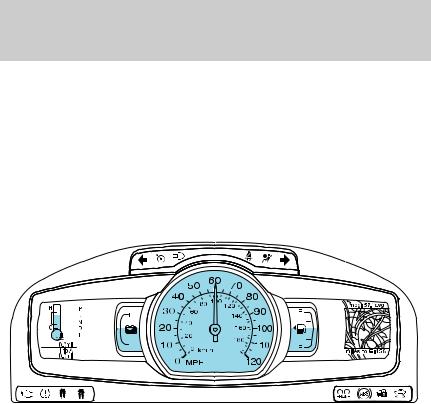
Instrument Cluster
GAUGES
Your vehicle is equipped with an LCD (Liquid Crystal Display), reconfigurable instrument cluster. You can choose from four information levels, and also customize certain options within each level. The instrument cluster also comes with a demo mode and tutorial feature to demonstrate the four instrument cluster levels. Refer to Message Center in the this chapter to choose the display level you’d like and to use the demo and tutorial modes.
Inform instrument cluster
The simplest of cluster displays.
23
2010 Fusion Hybrid (hfv)
Owners Guide, 1st Printing USA (fus)
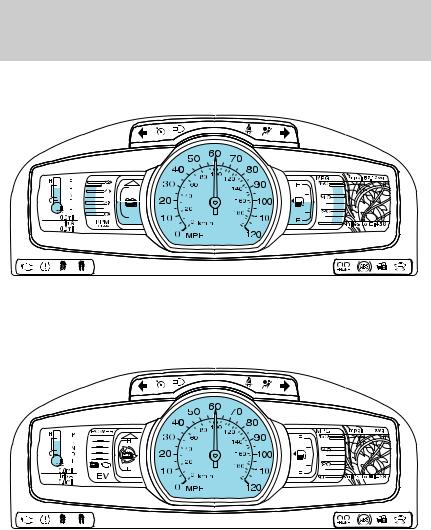
Instrument Cluster
Enlighten instrument cluster
Displays unique hybrid vehicle gauges, along with many of the familiar gauges from a conventional gasoline vehicle.
Engage instrument cluster
The next step in hybrid vehicle information, including innovative information displays intended to educate the driver about the hybrid system.
24
2010 Fusion Hybrid (hfv)
Owners Guide, 1st Printing USA (fus)
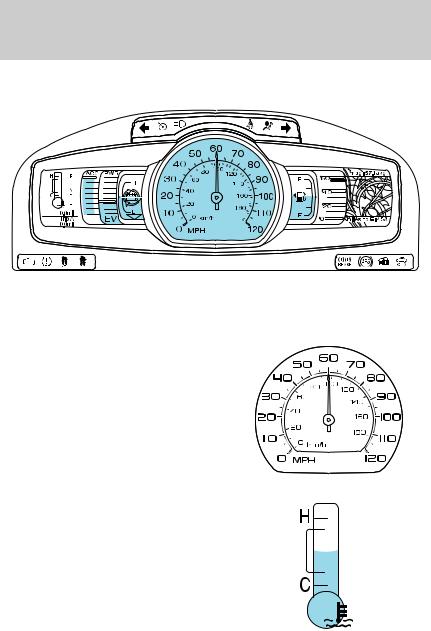
Instrument Cluster
Empower instrument cluster
The most information-rich display, with gauges designed to allow drivers to decide for themselves what driving behavior is most efficient at any given moment.
Speedometer: Indicates the current vehicle speed.
Engine coolant temperature gauge: Indicates engine coolant temperature. At normal operating temperature, the level indicator will be blue and will be in the normal range (between “H” and “C”). If the engine coolant temperature exceeds the normal range, the level indicator will change to red to indicate that the engine is overheating. Stop the vehicle as soon as safely possible,
switch off the engine and let the engine cool.
25
2010 Fusion Hybrid (hfv)
Owners Guide, 1st Printing USA (fus)
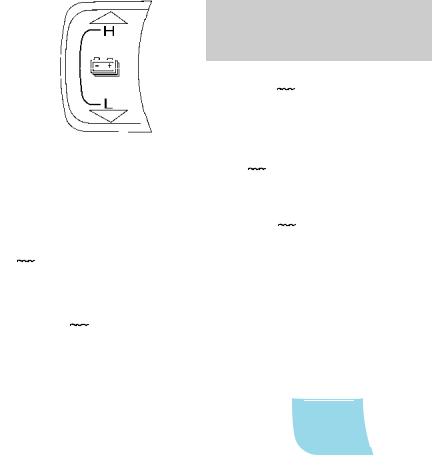
Instrument Cluster
Empower instrument cluster level only: The 
 indicator next to the gauge will illuminate in green or white to indicate the following:
indicator next to the gauge will illuminate in green or white to indicate the following:
•
 Indicator white: This indicates that the hybrid system is not warm enough to allow operation in electric vehicle mode only. The gasoline engine will run continuously when the indicator is white.
Indicator white: This indicates that the hybrid system is not warm enough to allow operation in electric vehicle mode only. The gasoline engine will run continuously when the indicator is white.
Note: During silent key start mode, the 
 indicator will be white, but the gasoline engine will not run. This is a result of the vehicle computer allowing the engine to be cooler during the silent key start period. This is normal operation and does not indicate a problem with your vehicle. After the first engine start, the
indicator will be white, but the gasoline engine will not run. This is a result of the vehicle computer allowing the engine to be cooler during the silent key start period. This is normal operation and does not indicate a problem with your vehicle. After the first engine start, the 
 indicator will turn green when the gasoline engine is warm enough to turn off.
indicator will turn green when the gasoline engine is warm enough to turn off.
•
 Indicator green: This indicates that the hybrid system is warm enough to allow operation in electric vehicle mode.
Indicator green: This indicates that the hybrid system is warm enough to allow operation in electric vehicle mode.
If the vehicle operates in electric mode long enough, it is possible that the gasoline engine may need to run to keep the system warm. In this case, the 
 indicator will revert back to white.
indicator will revert back to white.
High-voltage battery information gauge: The fill level indicates the amount of energy stored in the high-voltage battery as a percent of total energy capacity. The level will increase and decrease as the battery charges and discharges during normal operation, but the hybrid system will attempt to control the level to approximately the middle of the gauge under most driving conditions.
Enlighten, Engage and Empower instrument cluster levels only: The up and down arrows provide information about the energy (both stored and used) associated with the high voltage battery. The up arrow indicates battery charging, such as when extra energy is stored in the battery when coasting or braking. The down arrow indicates battery discharging such as when the battery provides extra power to boost the vehicle’s acceleration.
Engage and Empower instrument cluster levels only: A circular symbol appears in the center of the gauge when energy is being recaptured through the regenerative braking system. This indicates that your hybrid vehicle is capturing and using energy that would have been
26
2010 Fusion Hybrid (hfv)
Owners Guide, 1st Printing USA (fus)
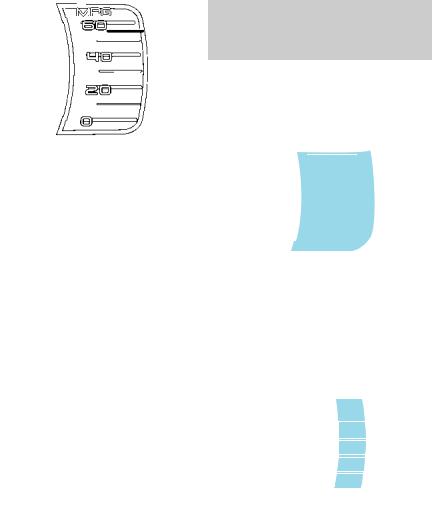
Instrument Cluster
lost in a conventional vehicle. The regenerative braking system can be activated by braking or coasting (i.e. even when you’re not pressing the brake pedal).
Fuel gauge: With the ignition on, this gauge indicates approximately how much fuel is left in the fuel tank. The fuel gauge may vary slightly when the vehicle is in motion or on a grade. When fuel level becomes low (50 miles [80km] to empty), the level indicator will change to yellow. When fuel level becomes critically low (0 miles
[0 km] to empty), the level indicator will change to red.
The fuel icon with the arrow points to the side of the vehicle that the fuel filler door is on.
Refer to Filling the tank in the Maintenance and Specifications chapter for more information.
Instantaneous fuel economy gauge: The instantaneous fuel economy is displayed in miles per gallon (or liters per 100 kilometers) from 0 to 60 mpg (or 0 to
30 L/100km). Your vehicle must be moving to calculate instantaneous fuel economy. If your instantaneous fuel economy is greater than
60 mpg, a “+” sign will be displayed next to the 60, indicating that the
current value is above the maximum that the graph can display. Instantaneous fuel economy cannot be reset. You may turn this gauge on or off at any information level. Refer to Message center in this chapter for more information.
Efficiency information gauge: You have three choices for displaying efficiency information: Efficiency Leaves, History Graph, or No Efficiency Information. You may make this selection at any information level. Refer to Message center in this chapter for more information on choosing the efficiency displays.
27
2010 Fusion Hybrid (hfv)
Owners Guide, 1st Printing USA (fus)
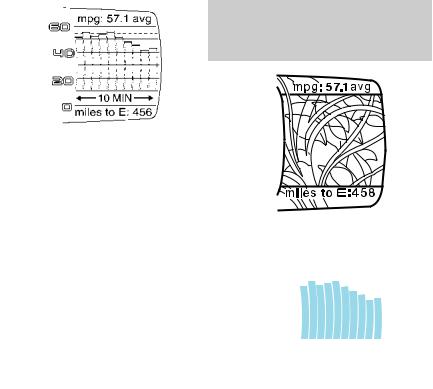
Instrument Cluster
Efficiency leaves: Indicates short term driving efficiency, measured over the last few minutes. The more leaves and vines that are displayed, the more efficiently you’re driving. Leaves and vines will occasionally appear and disappear to indicate a change in driving efficiency.
Note: The efficiency display can be impacted by your use of brakes,
accelerator and accessories as well
as environmental conditions such as terrain and weather.
History graph: Indicates average fuel economy in 10, 20, or
60 minute intervals. You can choose the interval using the message center. The graph is updated each minute with the fuel economy that was achieved during the prior 1, 2, or 6 minutes of driving, respectively. Each new average will be added to the left side of the graph, shifting the past data to the right. When the
graph area is full, the right most point will be deleted, keeping a running scroll with the bar on the left being the most recent. Note that previous values will remain when the vehicle is shut off and restarted, but values from a previous drive cycle will be grayed out. The average fuel economy since the last reset, or last 2,000 miles (3,200 km) of driving, is shown as a horizontal line across the bar graph.
Refer to Message center in this chapter for more information on the history graph display mode.
No efficiency information: If you choose, you may turn off both the Efficiency leaves and History Graph using the message center. In this case, the portion of your instrument cluster devoted to this information will be blank.
Refer to Message center in this chapter for more information on choosing no efficiency information.
Average fuel economy: Your average fuel economy in miles/gallon will be displayed at the top right of your vehicle’s instrument cluster or in liters/100 km at the lower right along with the efficiency leaves, history graph or no display (shown previously with history graph). You may
28
2010 Fusion Hybrid (hfv)
Owners Guide, 1st Printing USA (fus)

Instrument Cluster
reset this average at any time. Refer to Message center in this chapter for more information on the average fuel economy display mode.
If you calculate your average fuel economy by dividing distance traveled by amount of fuel used, your figure may be different than displayed for the following reasons:
•Your vehicle was not perfectly level during fill-up
•Differences in the automatic shut-off points on the fuel pumps at service stations
•Variations in top-off procedure from one fill-up to another
•Rounding of the displayed values to the nearest 0.1 gallon (liter) To determine your average highway fuel economy, do the following:
1.Drive the vehicle at least 5 miles (8 km) with the speed control system engaged to display a stabilized average.
2.Record the highway fuel economy for future reference.
It is important to press the RESET button to reset the function after setting the speed control to get accurate highway fuel economy readings.
For more information refer to Essentials of good fuel economy in the
Maintenance and Specifications chapter.
Distance to empty (DTE): Distance to Empty is displayed in the lower right for miles or on the top right for kilometers of your vehicle’s instrument cluster along with the efficiency, history graph or no display (shown previously with history graph). This function will give you an estimate of how far you can drive with the fuel remaining in your tank under normal driving conditions. Distance to empty will vary according to your driving habits.
DTE is calculated using a running average fuel economy, which is based on your recent driving history of 500 miles (800 km). This value is not the same as the average fuel economy display. The running average fuel economy is re-initialized to a factory default value if the battery is disconnected.
Turn your vehicle off when refuelling to correctly detect the amount fuel being added and allow this feature to work correctly.
Refer to Message center in this chapter for more information on the distance to empty display mode.
29
2010 Fusion Hybrid (hfv)
Owners Guide, 1st Printing USA (fus)
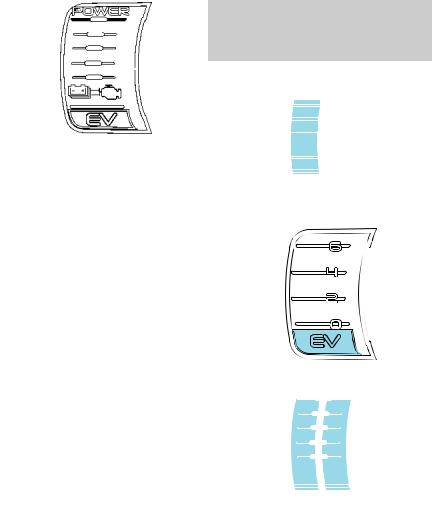
Instrument Cluster
Tachometer and EV mode gauge (Enlighten instrument cluster level only): When the gasoline engine is running, this gauge displays the engine speed in revolutions per minute (RPM). When the hybrid system is operating in electric vehicle mode (without the gasoline engine), EV is displayed. See EV mode only next.
EV mode only (Enlighten instrument cluster level only):
When the hybrid system is operating in electric vehicle mode only, EV is displayed.
Split power gauge (Engage instrument cluster level only):
This gauge indicates the power being supplied by the vehicle’s two power sources: the high voltage battery and the gasoline engine. When the hybrid system is operating in electric vehicle mode (without the gasoline engine), “EV” is displayed.
Maximum displayed gasoline engine
power is greater than the maximum displayed battery power.
30
2010 Fusion Hybrid (hfv)
Owners Guide, 1st Printing USA (fus)
